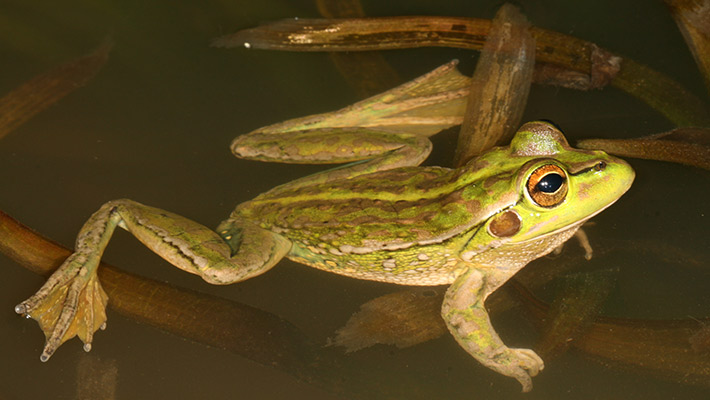Learn about Yellow-spotted Bell Frogs
Scientific name: Litoria castanea
Classification: Critically Endangered
Size: Up to 80mm
Distribution: Restricted to a single area of the Western Slopes near Yass in NSW
Habitat: Permanent waterbodies like ponds, lakes, and wetlands with grassy vegetation
Lifespan: Around 6 years
Primary Threats: Chytrid fungus, introduced fish, habitat loss from agriculture, water pollution, climate change
Where are Yellow-spotted Bell Frogs found?
This beautiful tree frog is restricted to a small area of New South Wales near the town of Yass, living in ponds, wetlands, and streams surrounded by vegetation. At night, males sometimes climb to the tops of reeds.
What a Spot!
Yellow-spotted Bell Frogs are bright green with golden patches on their back, and a white belly. The yellow spots near their hindlegs earnt them their name and can distinguish them from other bell frogs. The toes on the hindlegs are fully webbed.
Chytrid Crisis
The disease caused by the chytrid fungus has seen frog populations around the world decline and go extinct, including the Yellow-spotted Bell Frog. It can be spread through water or direct contact with other frogs, attacking the skin and supressing immune response. Populations declined rapidly in the 1970s and was believed to have been extinct at the time.
Today Yellow-spotted Bell Frogs are further impacted by loss of its habitat for agriculture, water pollution, and climate change. This frog is one of several amphibian species Taronga is working to protect from extinction.
Discovering the Dodo
After 30 years without sightings, many scientists thought the species was lost forever. In 2009, a scientist surveying native fish discovered an unusual looking tree frog that was later confirmed to be the Yellow-spotted Bell Frog.
A small number of frogs were collected by Taronga and transported to form an insurance population within a biosecure shipping container. This disease-free facility is designed to replicate wild conditions and provide optimum conditions for the frogs’ welfare and reproduction.
Road to Recovery
In 2018, our reproductive efforts paid off as over 750 Yellow-spotted Bell Frogs were returned to their natural habitat. In 2019, a further 1000 frogs were released. We are continuing to breed and study the frogs to secure their future.
